Near the village of Zlokućane, about a dozen kilometres northeast of Leskovac, there is an immovable cultural property in the form of an archaeological site called Gradac, located on an elevation. These are remains of a prehistoric (Neolithic) settlement discovered in 1909. However, although it was researched in the mid-20th century, the site has not been developed (there is nothing on it) and considering my unfortunate experiences with finding undeveloped archaeological sites, I didn’t even try to locate it precisely. I believe it is enough that I took a photo of the sign showing I was in Zlokućane, as that suggests I had good intentions. From my perspective, that’s quite sufficient.
 A sign by the road
A sign by the road
I also felt the need to stop at one spot to capture the South Morava River from a bridge.
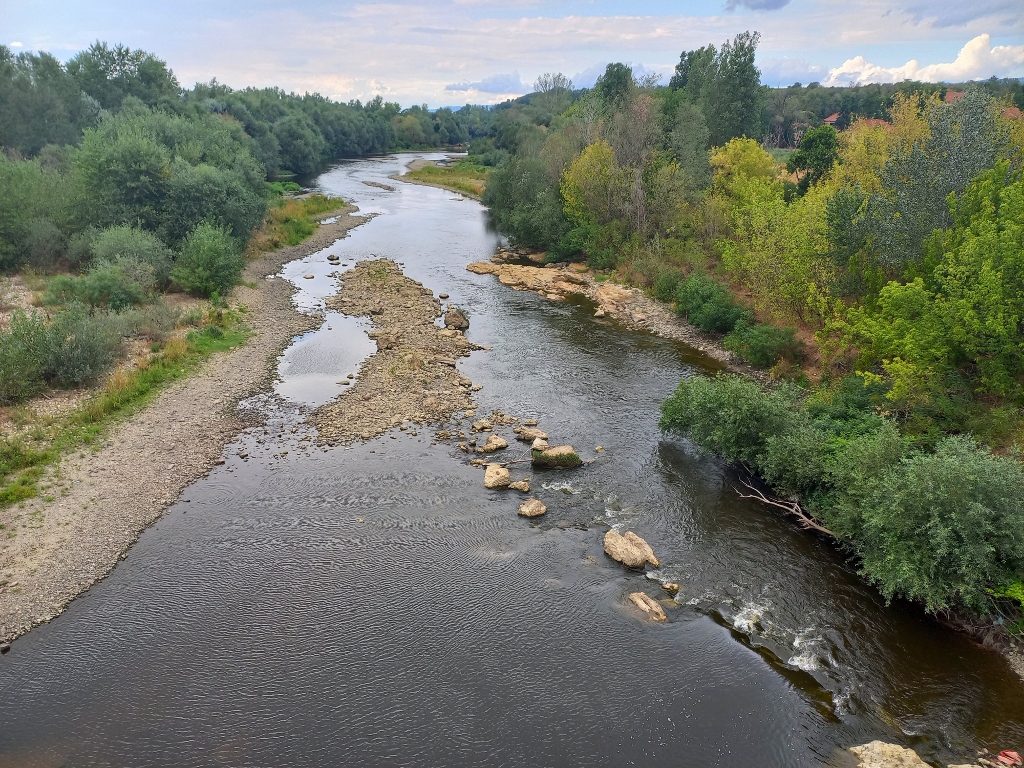 The South Morava River
The South Morava River
When I used to come to Leskovac as a child with my family during summer breaks, we regularly went on outings, most often to places with water where we could cool off. And that’s not hard to do in Leskovac. Namely, the Veternica River flows through the city, but there are also four other rivers in the area – the South Morava (the main watercourse), the Jablanica, the Vučjanka, and the Pusta Reka. In Serbia, it’s quite rare for a town to be surrounded by five rivers, but what matters to me is that I have very fond memories of those trips and enjoying the fresh water.
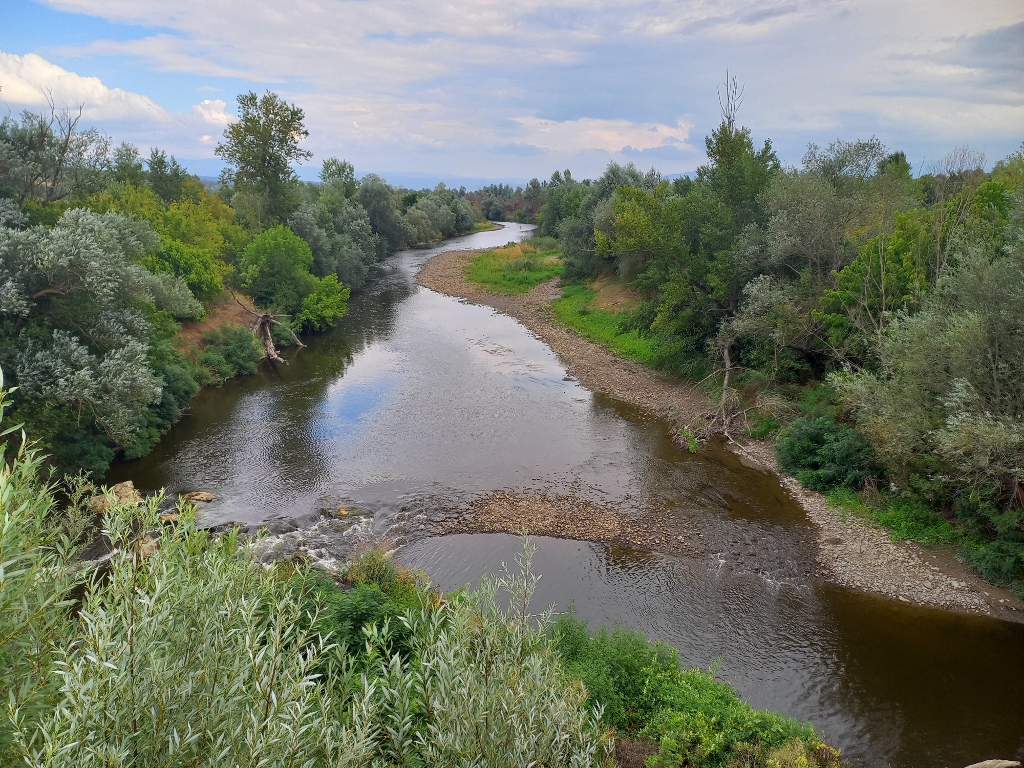 The South Morava River
The South Morava River
Something else that is also abundant in Leskovac and the surrounding area is peppers.
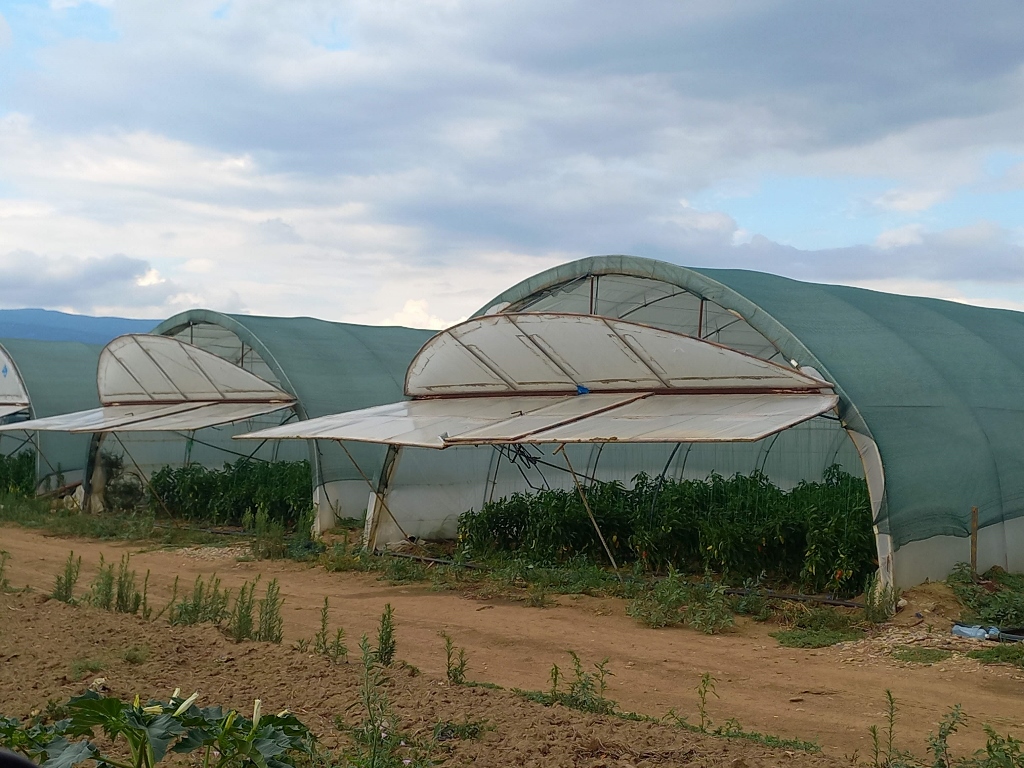 Growing peppers near Leskovac
Growing peppers near Leskovac
The village of Lakošnica, just under 15 km northeast of Leskovac, is especially known for its red peppers, which are dried in large quantities outdoors and cover the walls of houses (as they are hung there). There are actually two villages – Donja and Gornja Lakošnica – but this usually refers to Donja. On this occasion, we passed through the area of that village, but it was still too early for the peppers to be hung on the houses, as that usually happens later, from August to November.
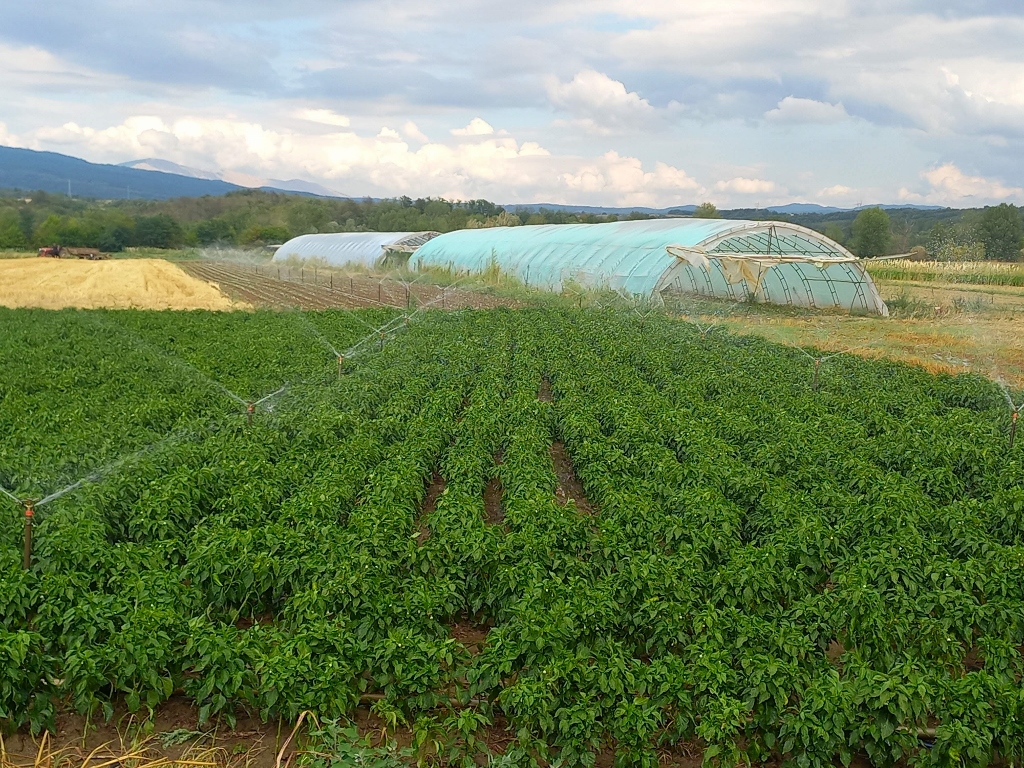 Growing peppers near Leskovac
Growing peppers near Leskovac
So, we didn’t go to that village, but instead continued towards another village called Babičko, located on the slopes of Babička Gora, about 20 km from Leskovac. In fact, a few kilometres before reaching Babičko, there is a turnoff and a dirt road that leads to an immovable cultural property – the Babičko Monastery.
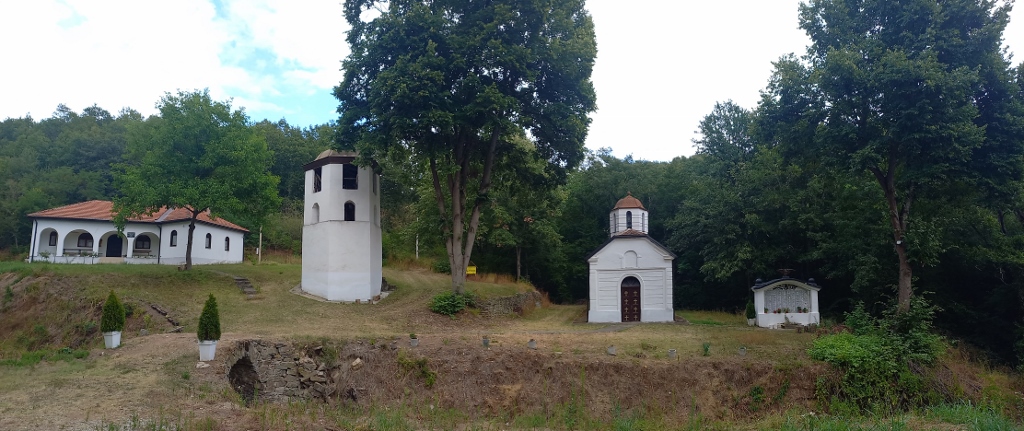 Babičko Monastery
Babičko Monastery
The monastery church is dedicated to the Holy Trinity and was likely built in the 16th century. It is a single-nave structure with a semicircular apse (which can be seen in one of the upcoming photos), and there is also a subsequently added narthex. However, no one was there and the church was closed, so we just took a short walk around the buildings.
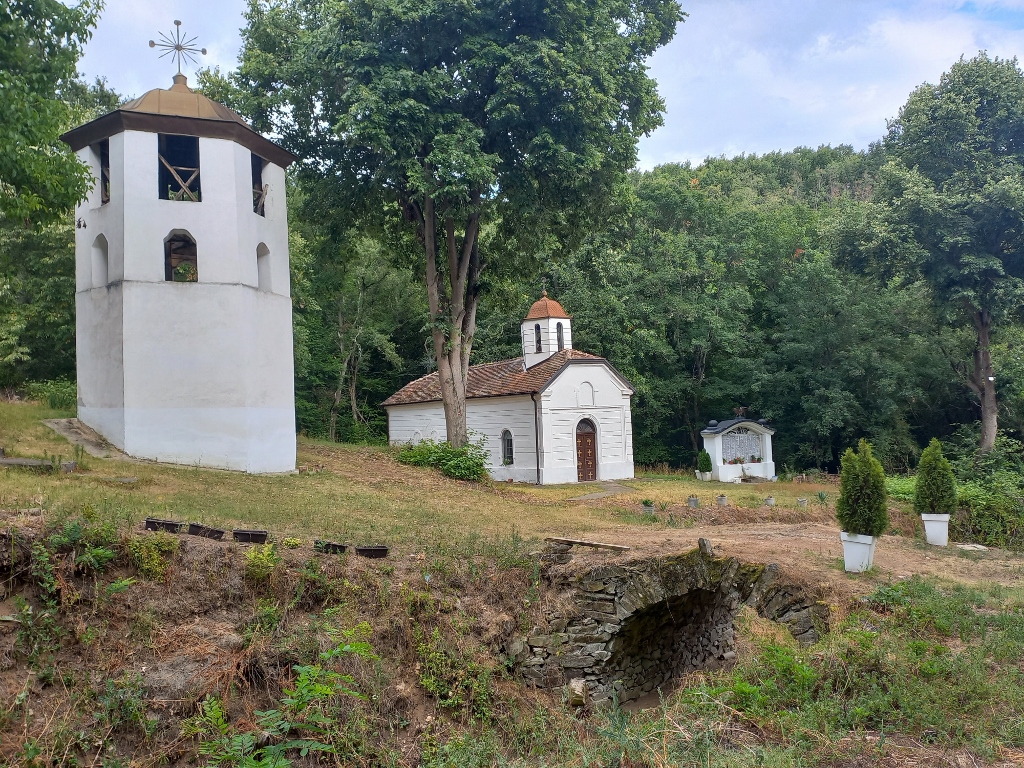 Babičko Monastery
Babičko Monastery
Next to the church, there is a memorial fountain dedicated to the soldiers who died between 1912 and 1920. I can report that the water was wonderfully fresh.
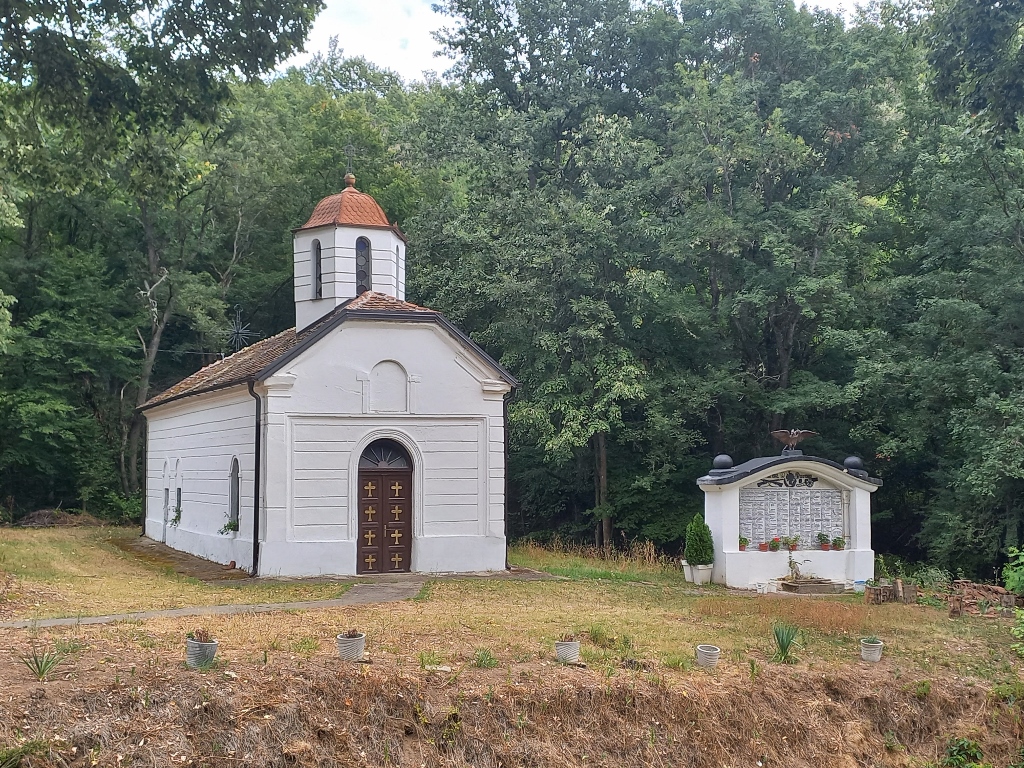 Babičko Monastery
Babičko Monastery
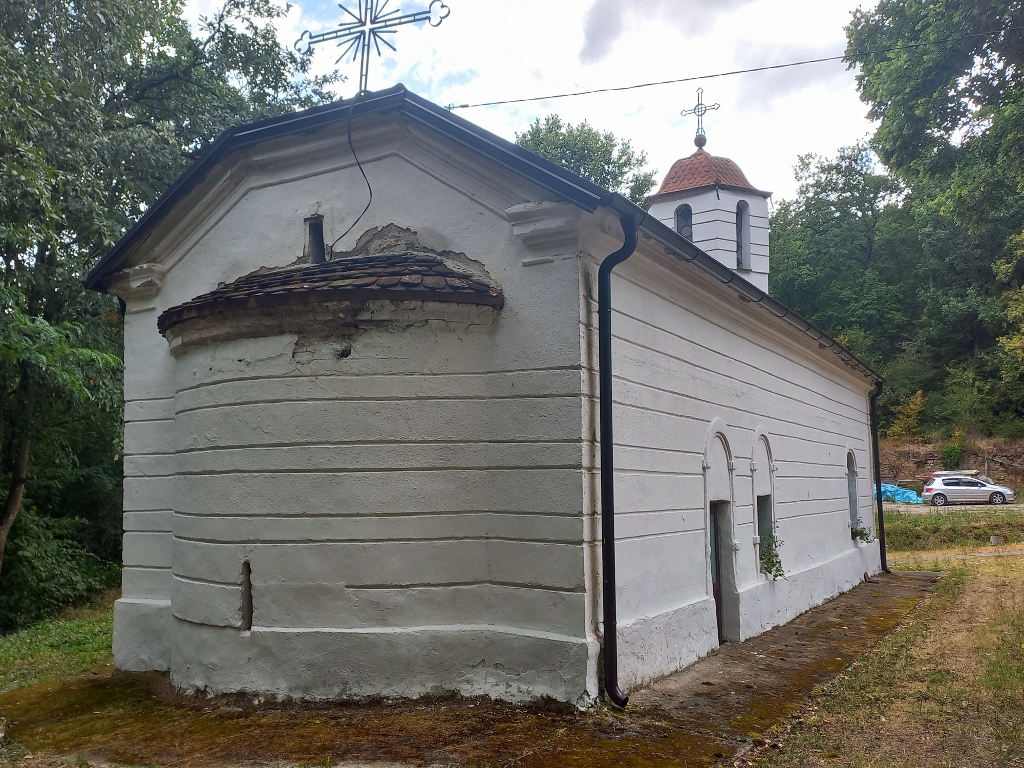 Babičko Monastery
Babičko Monastery
I took advantage of the windows on the side walls of the church and managed to take a few shots of the interior in that way.
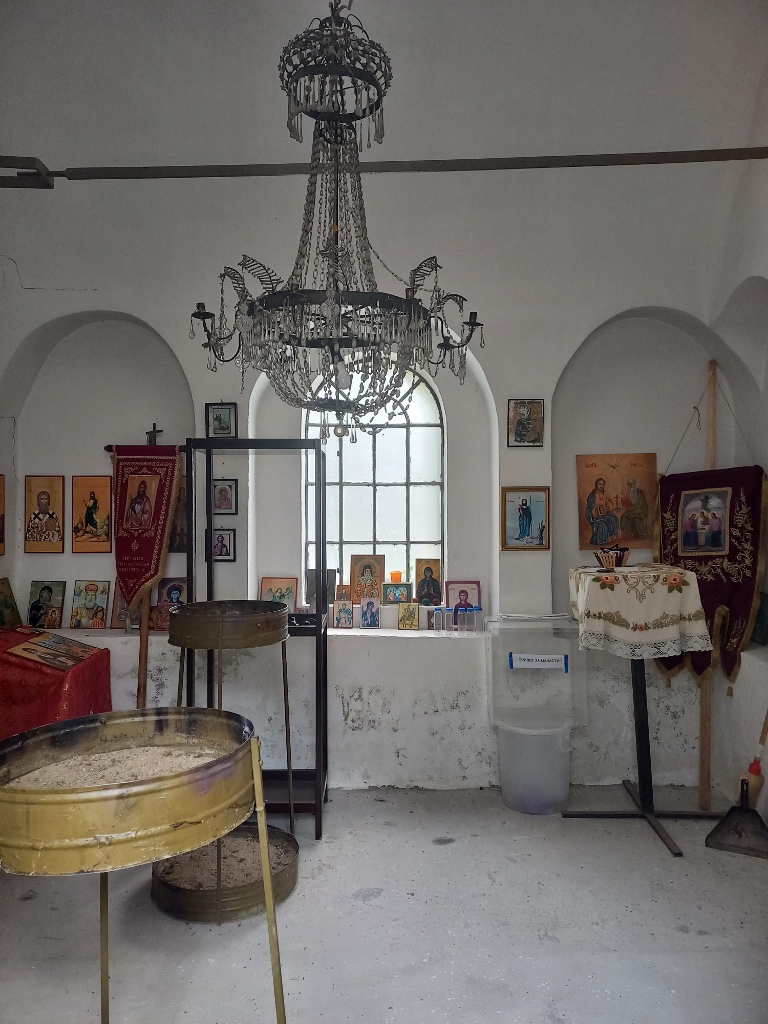 Babičko Monastery, a detail
Babičko Monastery, a detail
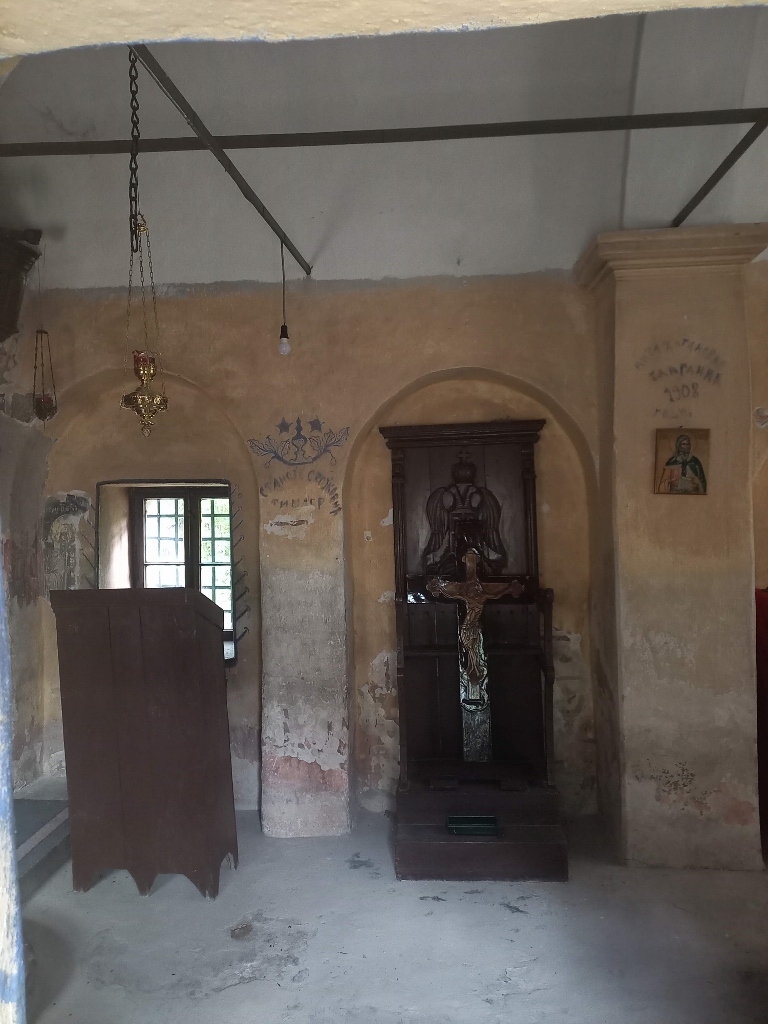 Babičko Monastery, a detail
Babičko Monastery, a detail
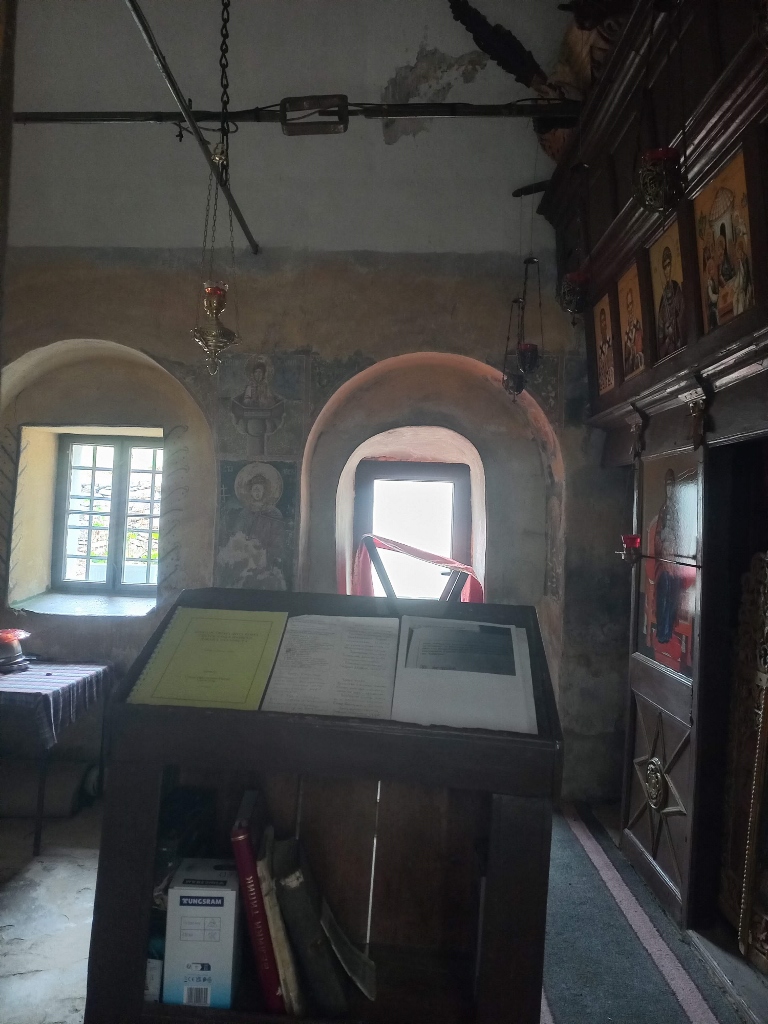 Babičko Monastery, a detail
Babičko Monastery, a detail
Based on what I read in my materials, I concluded that the monastery’s dormitory had since been demolished, as there was nothing at the site matching that description. What can be seen in the panoramic photo above (the building farthest to the left) is the former school, built in 1868. We thought we might have arrived during the afternoon rest period, but it’s also quite possible that there are no permanent residents here or that they may have gone out to take care of some business.
Still, this is quite a good place to visit and what I especially liked here is that there is a sign on the side showing the direction of a hiking trail. Generally speaking, I don’t think I’ve ever realised before what an amazing location Leskovac is in. Not only are there rivers that ensure the fertility of the valley (though also the possibility of floods), but the town is surrounded by numerous mountains that are not particularly high, yet they allow nature lovers and hikers to go on regular outings. During my stay, I saw signs with information, signs pointing some specific directions, and hiking trail markings in several places, so I believe there are enough enthusiasts. I’ll have to keep something like that for the next time.
We now got into the car and returned along the dirt road through the forest back to the main road.
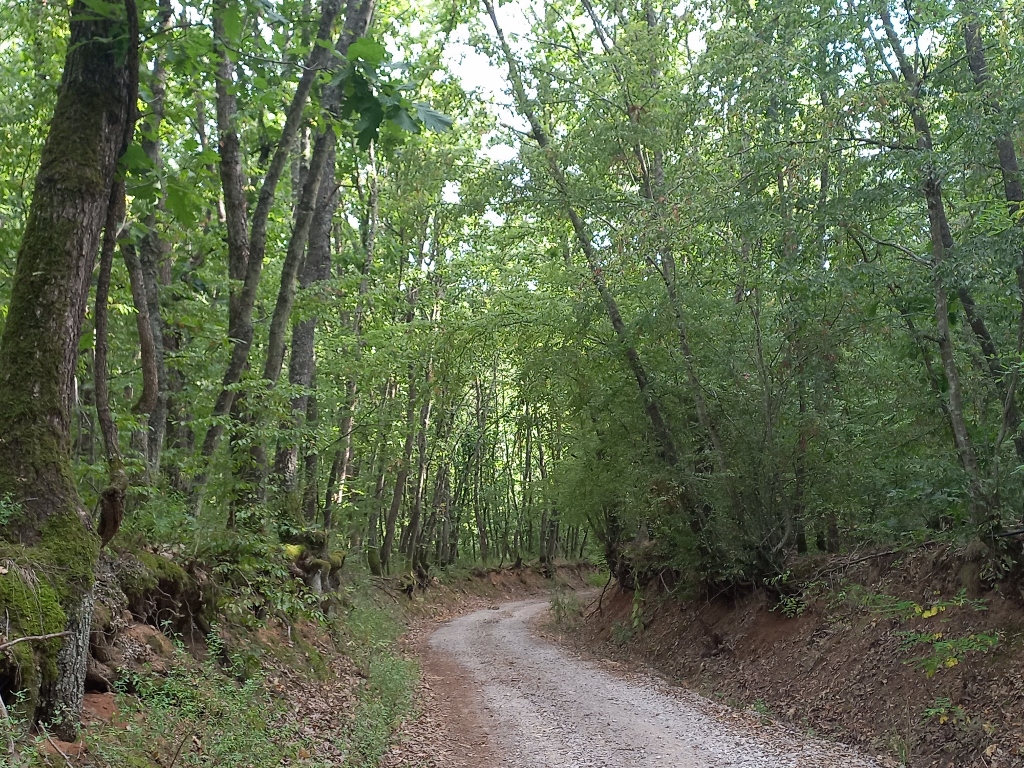 Road to/from Babičko Monastery
Road to/from Babičko Monastery
On the way back to Leskovac, I stopped at one more spot to take a photo of the surroundings. I could easily imagine myself walking for hours over the hills, if not in the high mountains, and enjoying it. Here, the emphasis is definitely on enjoyment.
 Surroundings of Leskovac
Surroundings of Leskovac
As for my stay in the city itself, I tried to take a short walk every day, at least in the late afternoon, and to find the cultural monuments that were on my list. In the end, I realised I had missed a couple, but as I like to say, you always have to leave something for the next time.
Besides that, I also met up with my other cousin on my father’s side, Olgica, and her daughter Marija. Locka (Olga’s nickname) is the daughter of my aunt, who is my dad’s cousin. For those who don’t come from traditional Serbian communities and families, this might sound confusing – but not in my family. However, it’s not just a matter of family ties; in this case, the connection with Aunt Canka (real name Aleksandra) is fundamentally important for my brother and me. Namely, it was she, as a friend of my mom’s, who was responsible for introducing her to my dad.
By the way, in Leskovac, it’s common for almost everyone to have a nickname, not just variations of their given name. At least, that used to be the tradition. This is also reflected in the names of some cultural monuments. For example, the previously mentioned Bora Dimitrijević-Piksla House, which I’ll talk more about a bit later. What’s interesting here is that the man was nicknamed “Piksla” (“Ashtray”). One can only assume he was a heavy smoker. Another example is my mother, who was called “Bumbar” (“Bumblebee”) because she was chubby as a child.
Now, to continue my virtual walk through the (wider) centre of Leskovac and my visits to various cultural landmarks.
One of these immovable cultural properties is the Vojvodić Family House, located at Vlade Đorđevića 23. This building stands out quite a bit from its surroundings in terms of its architectural style, as it predominantly features elements of Modernism.
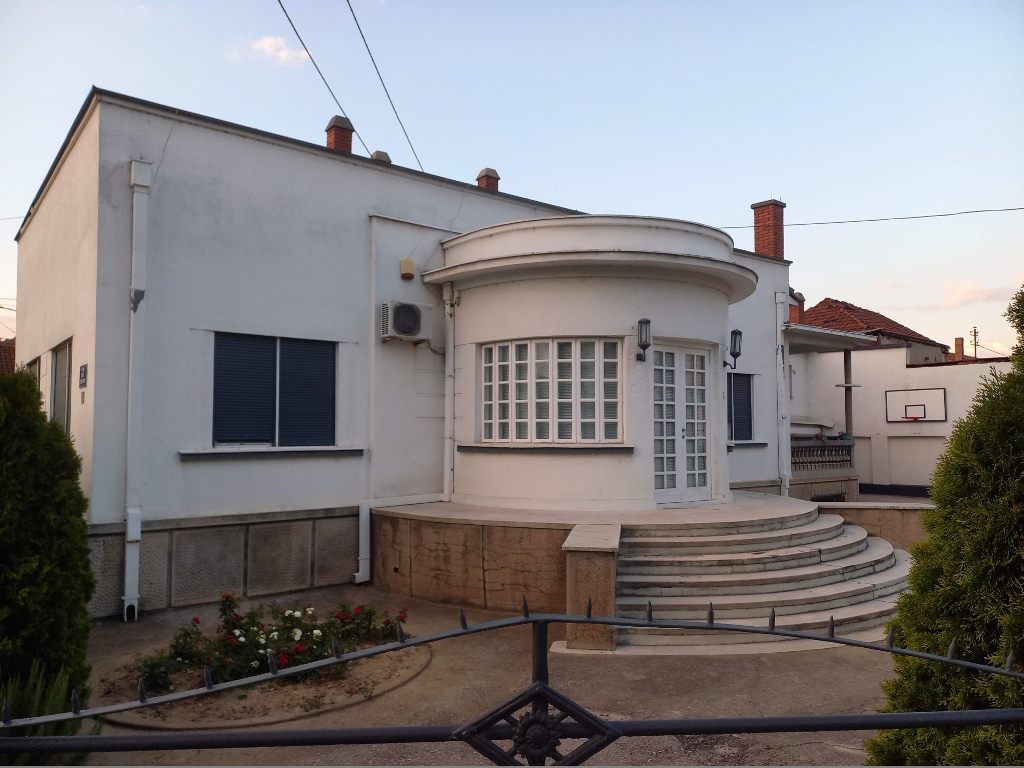 Vojvodić Family House
Vojvodić Family House
This house was designed by architect Grigorije Samojlov (1904–1989), who as a young man emigrated from Russia with his father in 1921. He was educated in the then Kingdom of Serbs, Croats and Slovenes, and completed his studies in architecture in Belgrade. He worked throughout the country and thus also left his mark in Leskovac (I’ll discuss another one of his works in this area a bit later).
In any case, the Vojvodić Family House was designed in the 1930s for the needs of a co-owner of a shirt and underwear factory.
This house is located in the immediate vicinity of the Veternica River, which flows through the city and there is also one of the bridges that crosses the river nearby.
 The Veternica in Leskovac
The Veternica in Leskovac
However, before I crossed the bridge and went to the other side of the river, I captured another cultural monument, as it’s actually best seen from that vantage point. It’s the Turkish House.
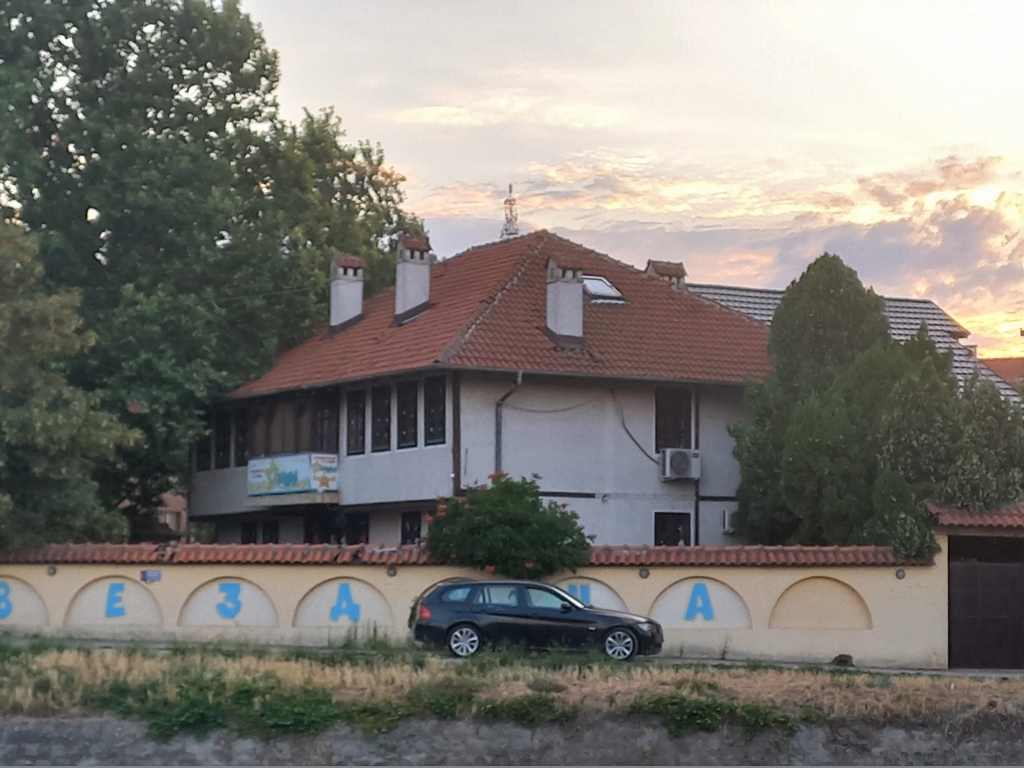 Turkish House
Turkish House
Although the house now features modern details, such as an air conditioner, a skylight and a more recently constructed roof, it is believed to have been built in the 19th century and is one of the very few structures built in the Balkan style that wasn’t torn down after Serbia gained independence from the Turks. At the time, many houses were constructed in this style, but it was considered “Turkish,” so people, eager to finally free themselves from everything Turkish, tore down those buildings and erected new ones.
The upper floor extends over the entire length of the house, resembling an oriel. In the centre of the upper floor is a closed wooden terrace, with four windows on each side, while the ground floor has two windows on either side.
When I was looking for this immovable cultural property, I had a bit of trouble, since the house wasn’t clearly visible from the street due to a tall wall and large, lush trees. Additionally, it turned out that the address listed in the documentation was incorrect; it states Miloša Obilića 1, but it is actually at number 2 (across from the house numbered 1).
Today, the building houses a kindergarten and since I was there in the evening, everything was closed, so I had to film the house over the tall fence (hence the “tilted” photo).
 Turkish House
Turkish House
From the other side, I managed to capture two interesting chimneys, as well as parts of the hipped roof.
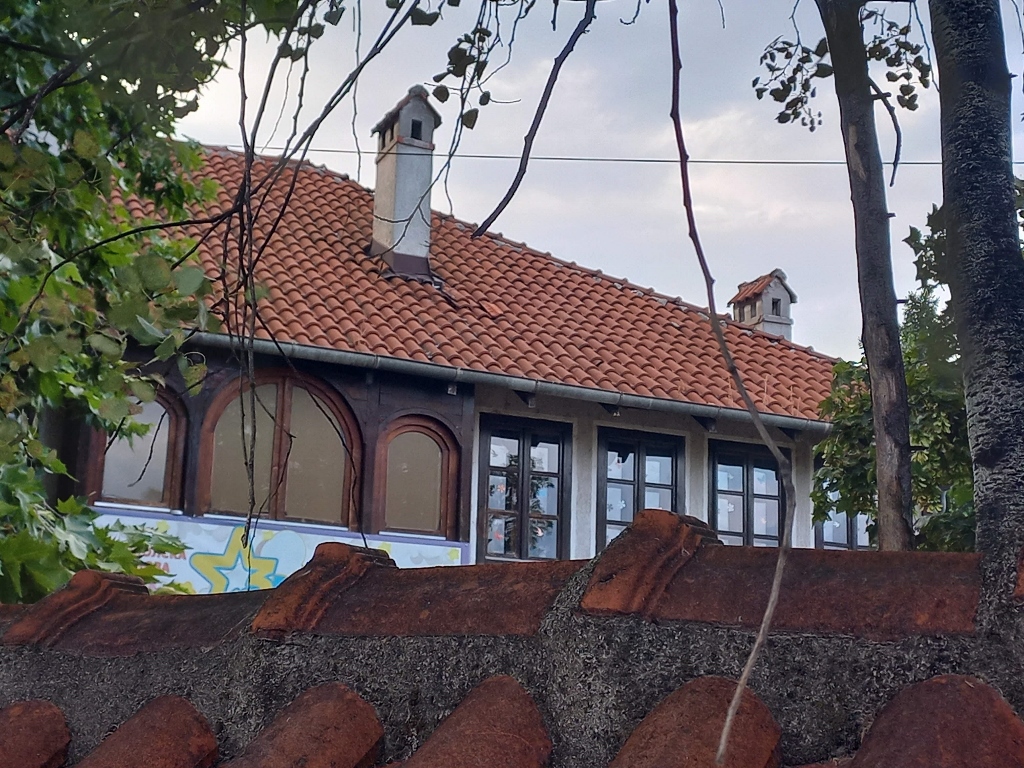 Turkish House, a detail
Turkish House, a detail
About a hundred metres further on, you reach the intersection with Svetoilijska Street, where the Urban House at Pasjačkog odreda 42 is located – Pasjačkog odreda being the former name of this street.
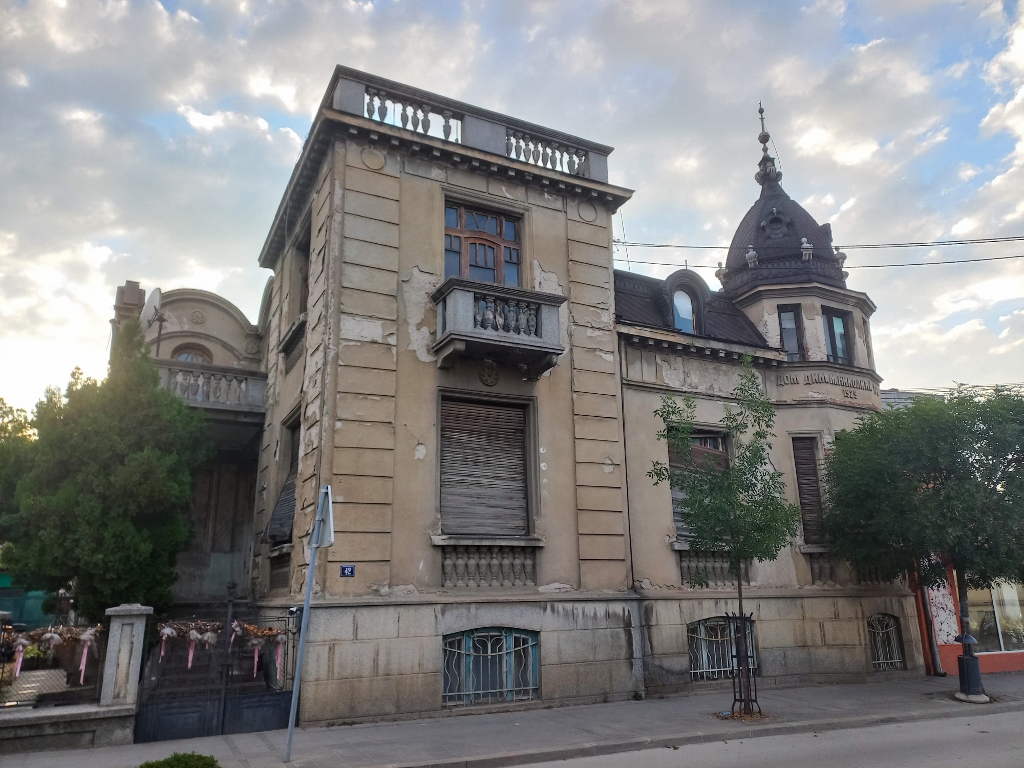 Urban House at Pasjačkog odreda 42
Urban House at Pasjačkog odreda 42
The building was constructed in 1929 as the family home of wealthy merchant Dimitrije Nikolić, as indicated on the circular corner section of the upper floor. It consists of a basement, a raised ground floor and an upper floor that is partially designed as a mansard attic.
Although it’s clear that the exterior of the house is not being maintained (I don’t know about the interior), various beautiful decorative elements can still be seen.
 Urban House at Pasjačkog odreda 42
Urban House at Pasjačkog odreda 42
Then I went down to Svetozara Markovića Street, which is the main street of the old merchants’ and craftsmen’s quarter. There are several immovable cultural properties, i.e., the monuments of culture, located there and the first one I came to was the Craftsmen House in Leskovac.
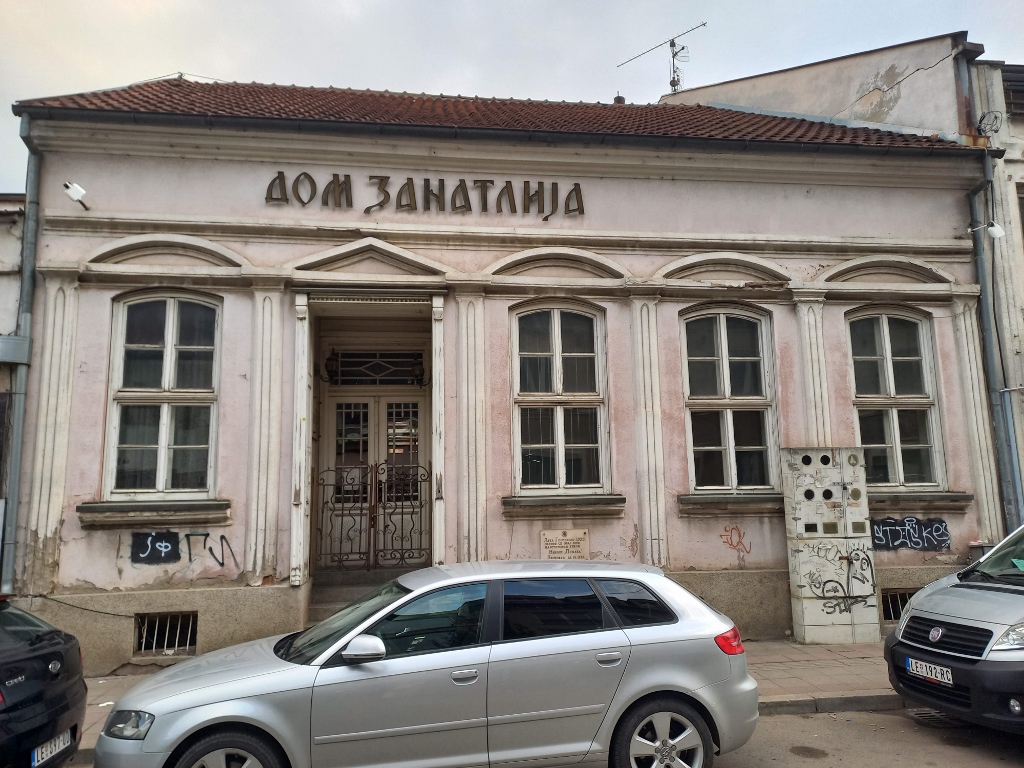 Craftsmen House in Leskovac
Craftsmen House in Leskovac
This building was constructed in the 1880s and originally served as a tavern, functioning as part of the street-facing row of the old bazaar. Despite its current state, which at first glance appears neglected, partly because of various fools who feel the urge to scribble on façades and partly due to the passage of time (even though the building was restored in 1995), a fair portion of the elegant decorative façade elements are still in good condition. The recessed entrance with double doors stands out in particular and its placement brings a sense of dynamism through the absence of symmetry, which is noticeable not only in the entrance recess, but also in the different decorative solutions above the window and door openings.
There are also a couple of plaques on the building that reflect its historical function. From 1935 to 1940, it served as the Trade Union House of the Leskovac workers’ movement, while today it is home to the offices of the General Association of Independent Entrepreneurs of Leskovac, as part of the Regional Chamber of Commerce.
I continued my tour of the cultural monuments along this same side of the street. A bit further on, I spotted the next interesting building: the “Residential and Commercial House at Svetozara Markovića 67,” also known as the House of Merchant Todor Tasić Zec, which is the shorter name that I’ll use. Incidentally, this merchant also had a colourful nickname (Zec means rabbit).
 Svetozara Markovića street in Leskovac, a detail
Svetozara Markovića street in Leskovac, a detail
As can be inferred from the original name of this cultural monument, it is a building that served a dual purpose, the ground floor housed commercial space with direct access from the street, which is now in a very neglected state, while the residential floors (as I understood from the description) are accessed through an entrance located on the eastern side of the building. That entrance was not visible from the street.
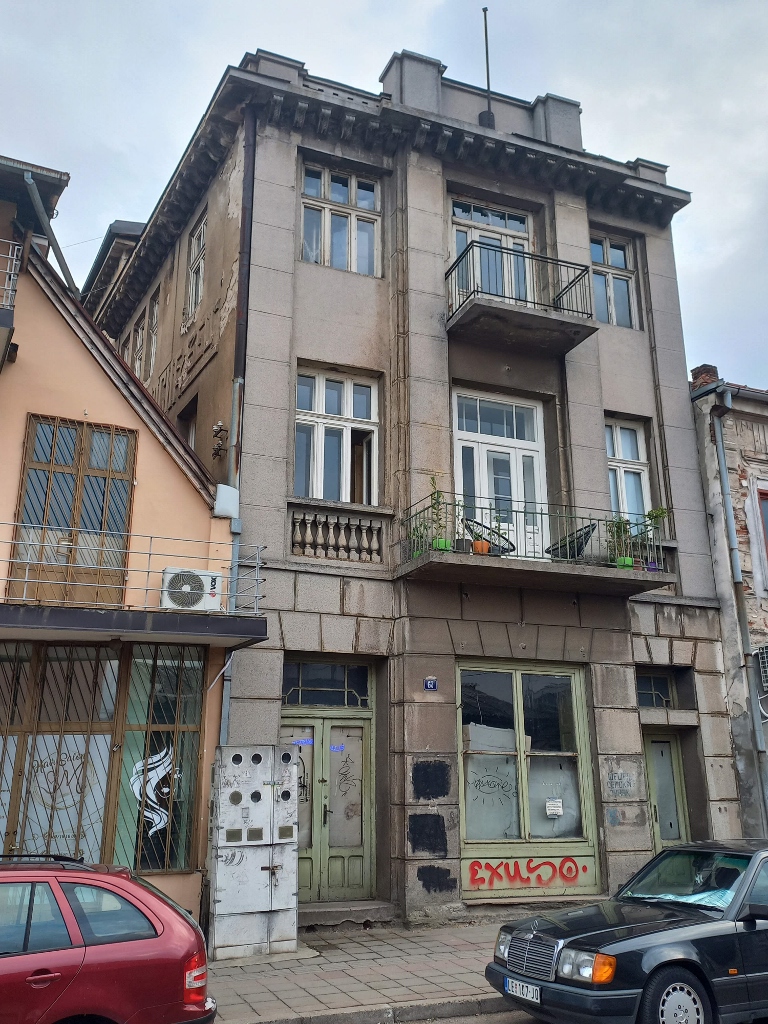 House of Merchant Todor Tasić Zec
House of Merchant Todor Tasić Zec
The building was constructed in 1935 and interestingly, as I found in the documentation, its height was equal to the width of the street – apparently a requirement at the time of its construction. Although the eastern façade is now partially obscured by a newly built structure, various interesting details can still be observed.
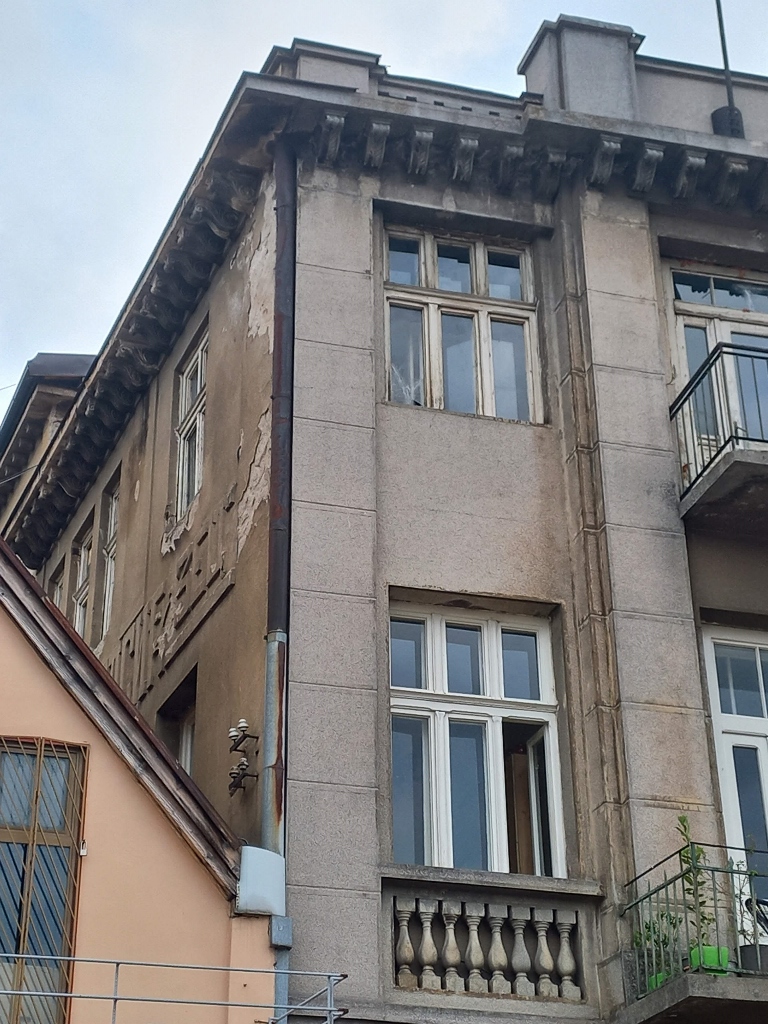 House of Merchant Todor Tasić Zec, a detail
House of Merchant Todor Tasić Zec, a detail
However, immediately to the west, there is another cultural monument – the Urban Residential House at Svetozara Markovića 69.
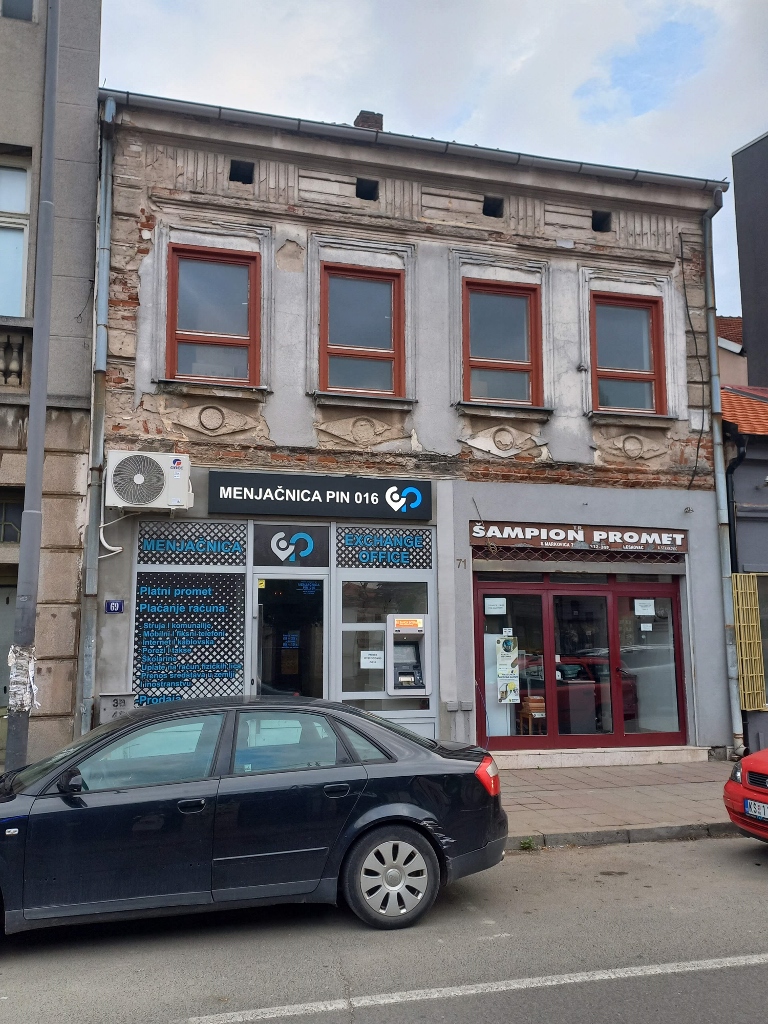 Urban Residential House at Svetozara Markovića 69
Urban Residential House at Svetozara Markovića 69
The house was built in the early 20th century and, although it appears to be in poor condition, elements of the façade decoration popular at the time of the construction can still be seen. This house also had a mixed residential and commercial function, though I’m not sure why it wasn’t built to match the “street-width equals height” rule.
Still, despite the differences in size and appearance compared to the neighbouring building, all of these houses should be viewed as part of a specific spatial and architectural ensemble that developed during the first half of the 20th century (up to World War II).
Today, just a few dozen metres away, one can see buildings that reflect entirely different trends and desires.
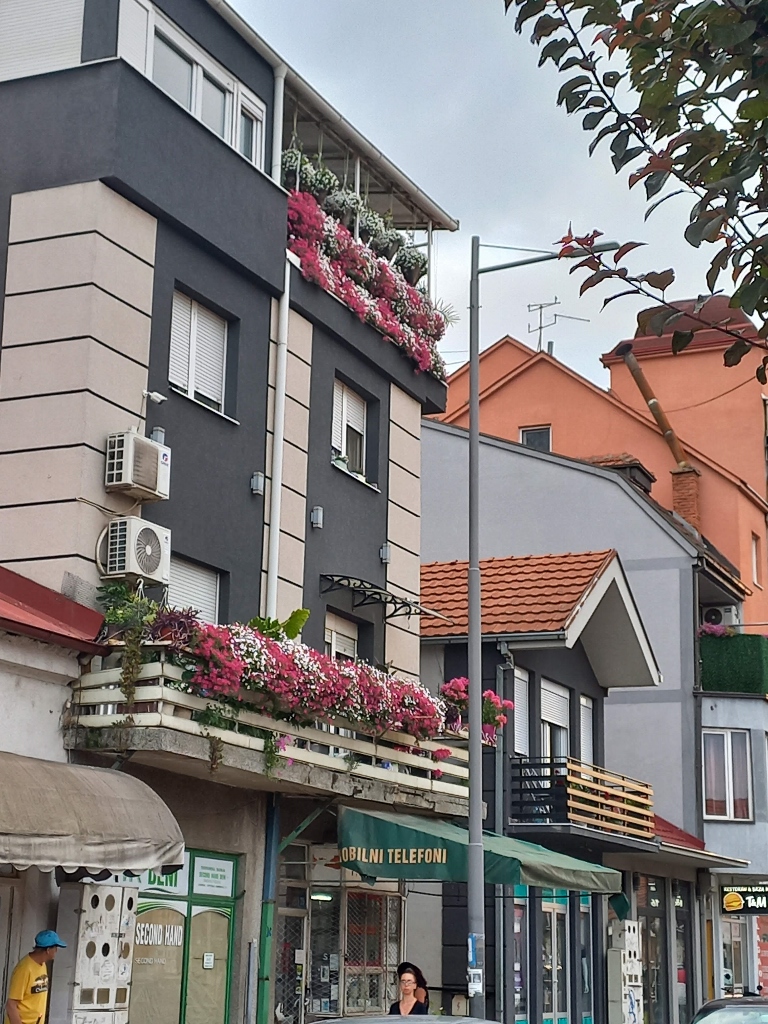 Svetozara Markovića street in Leskovac, a detail
Svetozara Markovića street in Leskovac, a detail
But when it comes to old houses, there is one more cultural monument on this street, although it’s on the opposite side. The problem, in my case, arose due to an incorrect house number listed in a section of the documentation I was using. Even where the correct address is mentioned, the accompanying photograph is wrong. That’s why I was confused when I saw a completely unremarkable house (the one visible in the photo in the documentation), which had no notable features. It was only later that I realised I had the wrong house, so I’ll have to correct this on my next visit to Leskovac.
As I made my way back towards the centre, I also went to Branislava Nušića Street, where there are two immovable cultural properties categorised as monuments of culture.
The first is the Catholic Church Building in Leskovac, a structure built between 1927 and 1933.
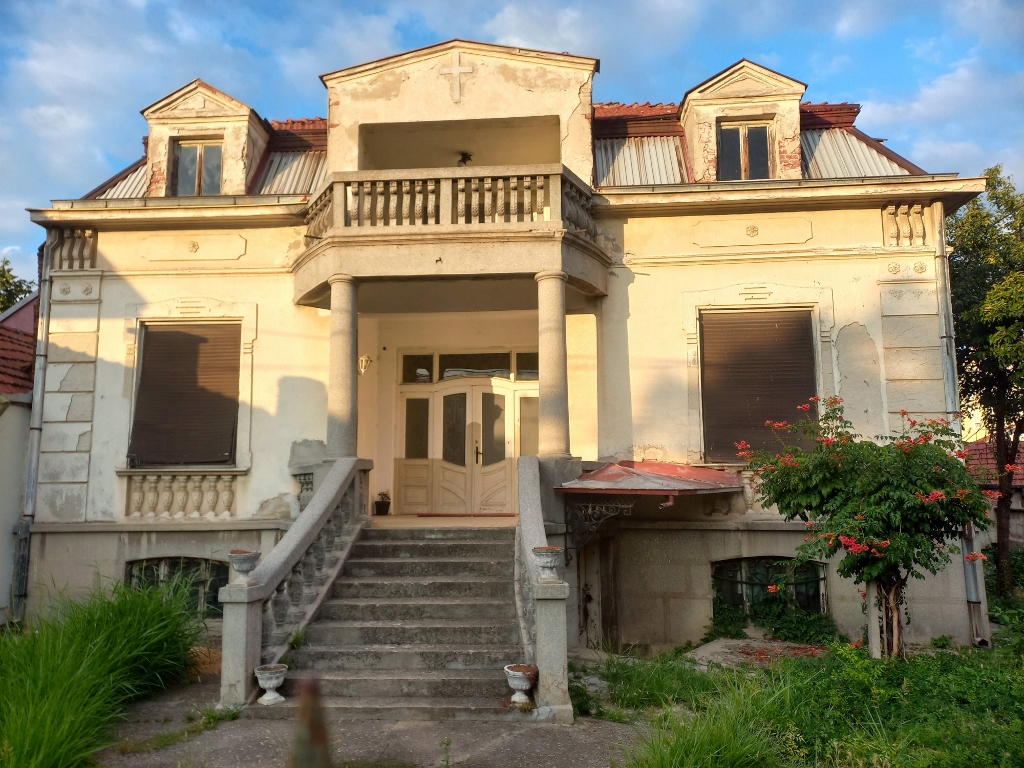 Catholic Church Building in Leskovac
Catholic Church Building in Leskovac
I must admit I have no idea what the function of this house actually is, since it doesn’t resemble a church, nor do I know who lives there or who owns it. However, aside from the impressive central entrance section with a staircase and an upstairs terrace, there is a decorative element at the top of the central part, a cross, which hints at its religious purpose. I also came across a note stating that this “spiritual space” is dedicated to the Blessed Virgin Mary, Queen of Heaven.
Directly across from this building is the “Urban House at Branislava Nušića 25,” another cultural monument. It was given this status because, like the other urban houses I’ve mentioned, it represents a historically significant structure.
 Urban House at Branislava Nušića 25
Urban House at Branislava Nušića 25
Just as a reminder, from the late 19th century, specifically after the liberation from the Ottomans in 1877, until World War II, Leskovac experienced significant growth, primarily through the development of the textile and chemical industries, along with expanding trade. Members of the newly wealthy families began building family homes that reflected the spirit of the new era in their design and architecture.
The same is said about the house located at this address, but it’s in such poor condition and appears so abandoned that I’m not entirely sure it's the right one.
 Urban House at Branislava Nušića 25, a detail
Urban House at Branislava Nušića 25, a detail
I found myself wondering how and why certain houses were declared cultural monuments. That question especially came to the forefront when I passed by a house in another part of the town, clearly built in 1931 (it's written on the building), evidently belonging to the urban middle class, since homes like that certainly weren’t built by the poor. It appears to have very beautiful and interesting architectural elements and, on top of that, it’s wonderfully maintained and clearly inhabited.
 Leskovac, a detail
Leskovac, a detail
But let me get back to the part of the town where I had just stopped. In the parallel street, there is also the Urban House at Đorđa Lešnjaka 1.
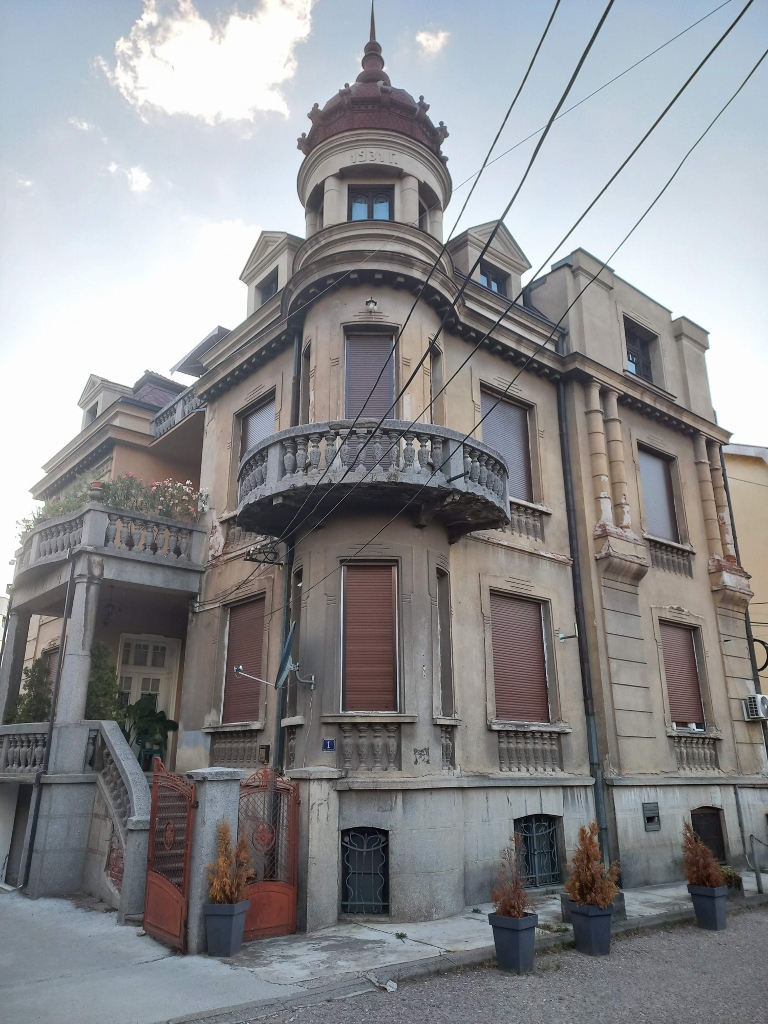 Urban House at Đorđa Lešnjaka 1
Urban House at Đorđa Lešnjaka 1
It was built in 1931 and is a classic example of urban residential architecture from the interwar period. The house was designed as a multi-story corner building, with the street-facing façade featuring only windows, while the entrance staircase and spacious terrace are located on the side facing the courtyard. Still, each floor displays different decorative elements on the façade.
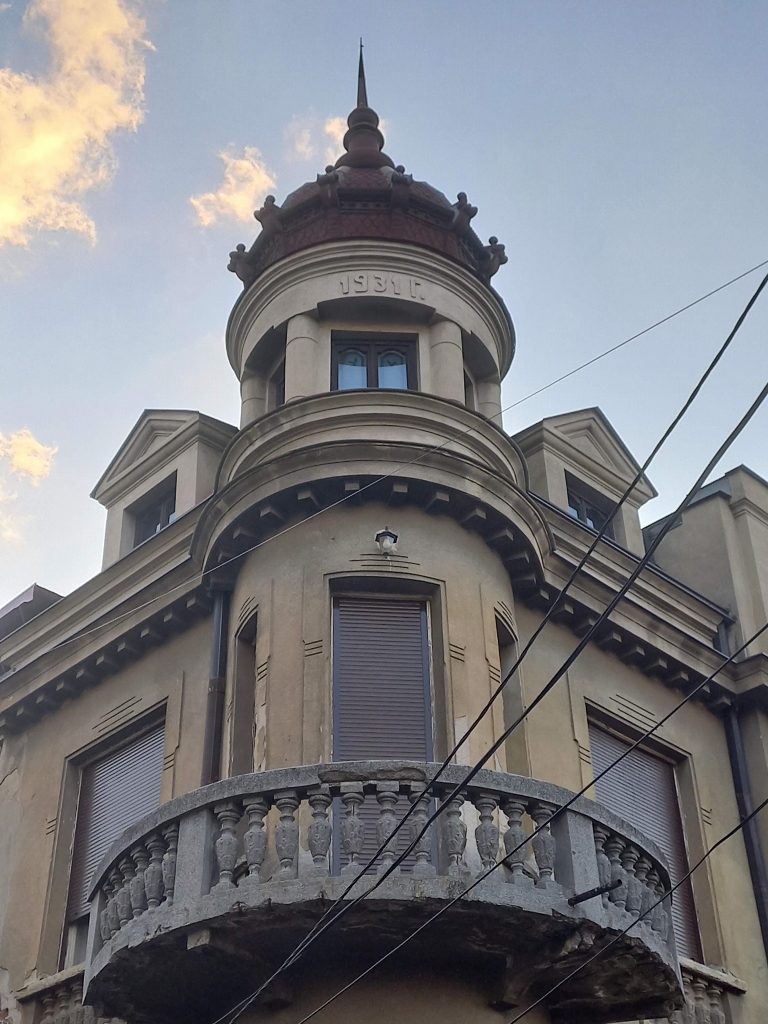 Urban House at Đorđa Lešnjaka 1, a detail
Urban House at Đorđa Lešnjaka 1, a detail
In the next parallel street, which is one of the main streets in town, there are a couple of cultural monuments in the form of old buildings, but I’d like to start with probably my biggest surprise during this visit to Leskovac. You see, almost every time I’ve been here, for one reason or another, I’ve walked down this street, and after the names of the streets where my grandmother and aunt lived, this was the next street in town whose name I remembered. It’s simply called Niška. Except that it’s actually not true. Only now have I realised and learned that the street is actually named Južnomoravskih brigada.
But I’m certainly not the only one who gets the street name wrong, as everyone I’ve ever talked with mentioning this street calls it Niška. I guess the name stuck from much earlier times, when this street (which might have really been called Niška before World War II) continued on the road that leads to Niš, the largest city in southern Serbia, about 50 km to the north.
Anyway, on this street there is the Building at Južnomoravskih brigada 83. The building is located in the part of the town where a large market is, so there are many shops around and it seems busy all day long, but you can still see it clearly, although the electricity pole in front spoils the view quite a bit.
 Building at Južnomoravskih brigada 83
Building at Južnomoravskih brigada 83
The building was constructed in 1926 as a residential-commercial property and was owned by a well-known hemp trader. The main structural elements are made of reinforced concrete, although this is not visible. What can be seen is a beautiful bay window and symmetrically placed facades on the front, as well as a bay window on the side wall.
Since the building was also used for commercial purposes, on the ground floor, besides three doors, there are large openings used as display windows.
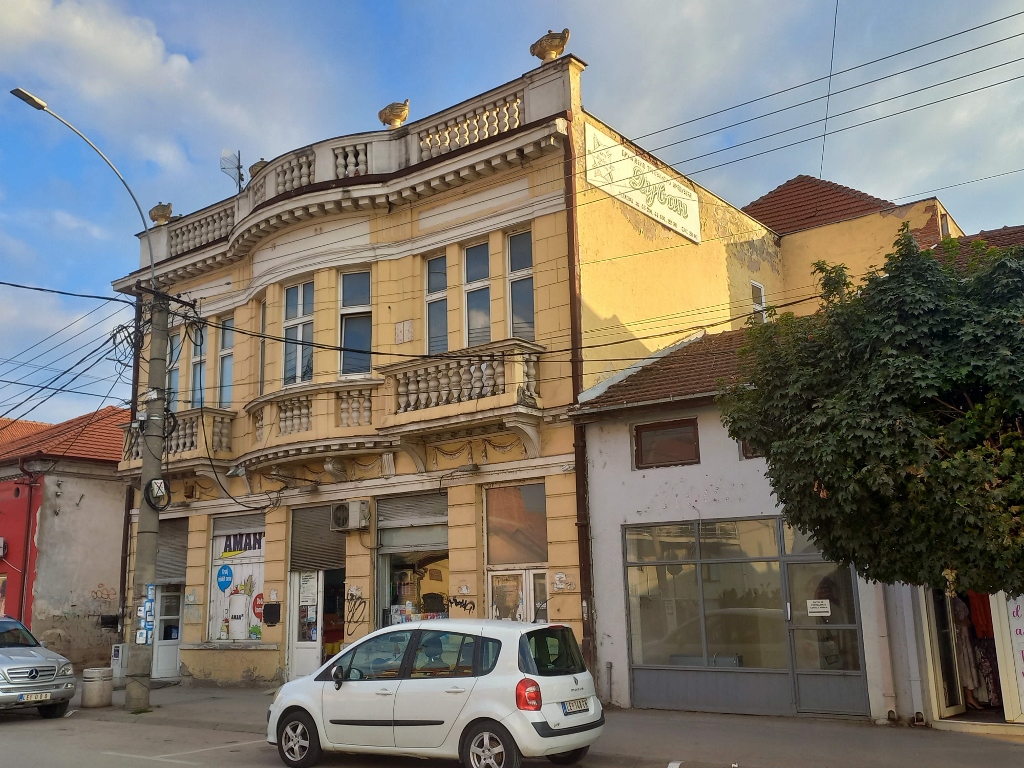 Building at Južnomoravskih brigada 83
Building at Južnomoravskih brigada 83
The facade decoration is very elegantly designed with many elements of classical form, while at the top of the facade there is a roof attic running the entire length, adorned with decorative vases. As is the case with many buildings, some of which are cultural monuments and some are not, graffiti-covered walls, neglected woodwork, and parts of the facade falling off significantly affect the appearance of these buildings and create an impression of ugliness. In the next picture, you can see how nicely it looks on the upper floor, which is harder to damage.
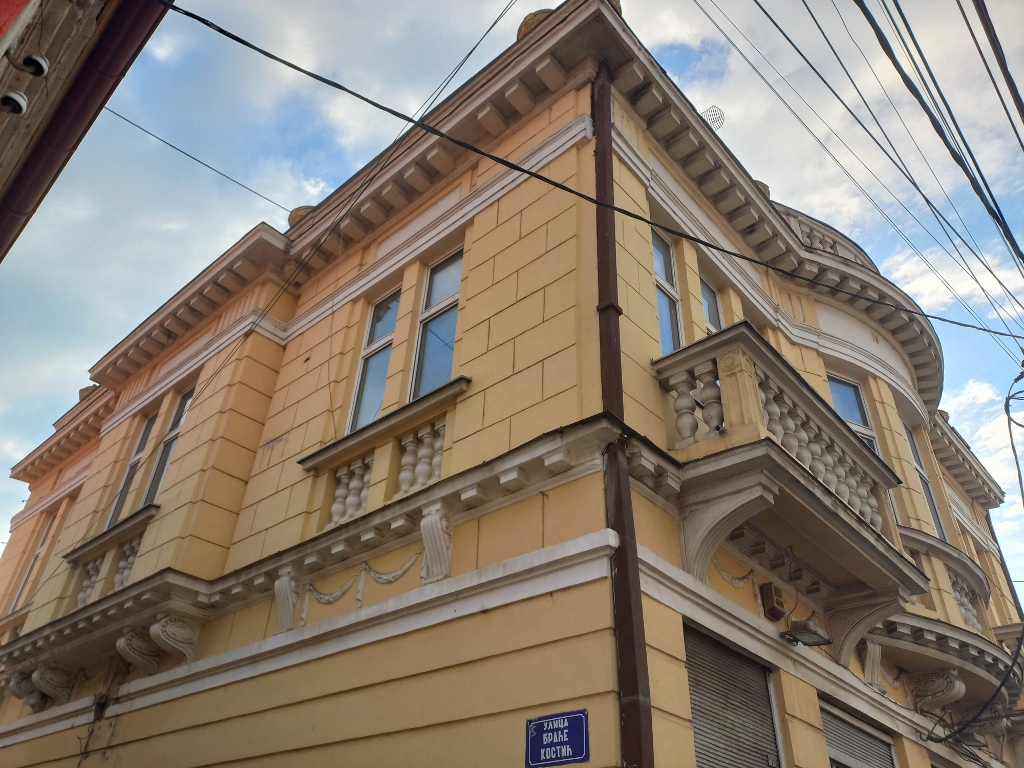 Building at Južnomoravskih brigada 83, a detail
Building at Južnomoravskih brigada 83, a detail
A little further down, on the same side of the street, there is another immovable cultural property, the Urban House at Južnomoravskih brigada 93. In front of this house, there is also a utility pole, but even its absence would not help improve the impression left by this cultural monument.
 Building at Južnomoravskih brigada 93
Building at Južnomoravskih brigada 93
This is a house built in 1909 that also belonged to a well-known merchant. The house served as a commercial warehouse, with the sales area on the ground floor and rooms on the upper floor.
It is truly a shame that this house is not in better condition because only upon closer inspection can one see the wealth of very beautiful decorative details, starting with the balcony with an iron railing in the middle of the upper floor, to the now modest remains of pilasters with fluting at the edges of the upper floor, topped with Baroque medallions inscribed with the year of construction and the initials of the building’s owner (visible in the previous photograph).
 Building at Južnomoravskih brigada 93, a detail
Building at Južnomoravskih brigada 93, a detail
Here I finished with the cultural monuments I planned and managed to find on the left bank of the Veternica, so now I went to one of the bridges in the centre and crossed to the right bank.
For now, here is again the map marking not only these various objects I saw in Leskovac, but also the places I visited outside the city while staying here at the end of July 2025.